Sustainable building is on the rise as the UK takes major steps towards its Net Zero future. In order for this to happen older buildings (listed properties, churches, etc.) will need to work closely with architects and chartered building services engineers. These changes aren’t simple and often involve updating the mechanical, electrical and plumbing design of these traditional properties, without affecting the historic elements.
Most newer buildings will be aiming to achieve Code 6 under the Code for Sustainable Buildings. This means that the properties will be seen as fully sustainable and are considered Net Zero.

What Makes a Net Zero Property?
Net Zero properties will include a number of features to enable them to be as efficient as possible, and reduce emissions and energy consumption. These include:
- Super-isulated walls, windows and roofs.
- Ground-source heat pumps.
- Energy and water saving appliances (such as toilets, low energy lighting, etc.)
- Rainwater harvesting.
- Solar paneling.
There are also elements of the contruction that can be managed, like minimising the waste produced on-site and ensuring you’re using environmentally friendly materials.

Planning for the Future
As we begin retrofitting and building new properties for the UK’s greener future, we need to plan for the entire lifetime of the buildings. We can’t just plan for Net Zero in 2030, but we need to plan for far beyond this. Some of these buildings have been around for generations and we need to ensure we prepare them to withstand all elements of the climate crisis.
Net Zero initiatives aim to slow the temperature increases and environmental changes brought about by the climate crisis. For example, it’s estimated that global temperatures will rise by a further 2-4 degrees celcius within the 21st century. This will predominantly be felt on land and within the built environment, as temperatures at sea will maintain themselves better.
Average temperatures in the UK summers could be around 35 degrees celcius, with highs estimated to be 40 degrees celcius or more. We need to design now so that properties and their occupants are able to withstand these increases.

Retrofitting and Altering Properties
When alterations are being made to historic or existing properties, you should be designing them to make sure they last to the end of their lives. That being said, interior fittings will generally not last as long as exterior. There will however be further opportunities to retrofit interiors and include additional upgrades to the properties.
When choosing an MEP Design team to support you, it’s important to use a company that has a clear focus on sustainability. SEA Consulting have been working with UK property owners for the last 40 years, ensuring their buildings are as efficient as possible and stand the test of time. Find out more about how we can help you below.

